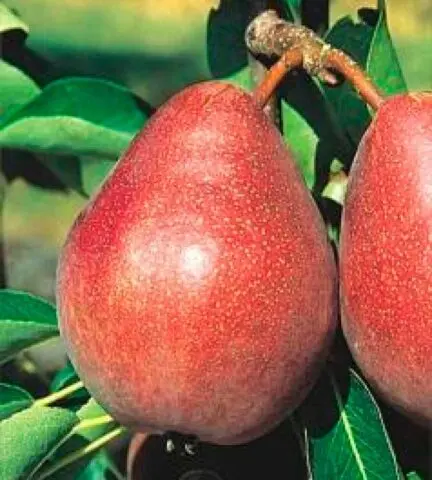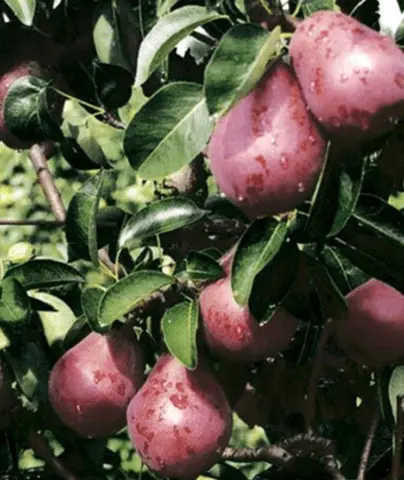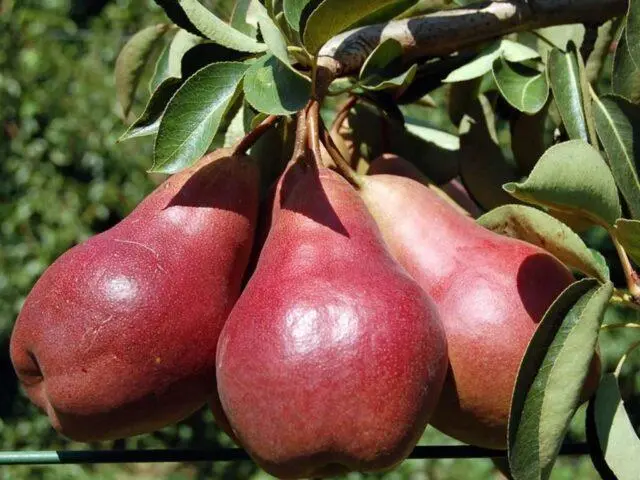Contents
Pear Carmen is a rather rare variety bred in Our Country relatively recently. Differs in large red fruits with pleasant sweet taste and juicy pulp. Suitable for growing at home and in industrial conditions.
History of breeding
The pear variety Carmen was obtained on the basis of the All- Research Institute. Michurin. The author is the breeder Yakovlev S.P. He conducted a selection of varieties William Red and Daughter Blankova. The variety is not yet included in the register of breeding achievements. It is currently undergoing state tests.
Description pear Carmen with photo
The variety is a fast-growing tree that produces attractive red fruits. A description of the main external features is presented below.
Tree
Pear Carmen grows quite quickly, the crown is narrow pyramidal, compact, height up to 2,5-3 m. The tree does not take up much space. Branches depart from the central trunk at sharp angles. Her shoots are quite thick, grow straight, partly cranked. The color is brownish-brown, the buds are small, pressed against the surface, the type is conical.
The leaves of the Carmen pear are medium, round-elliptical in shape. They are slightly pointed, have a reddish tint, shine beautifully in the sun. The leaf plate is weakly folded, slightly curved, with fine-grained, smooth edges. Stipules are long, subulate. The foliage diverges at sharp angles.
Fruit
The fruits of the pear variety Carmen are small, typical in shape, regular, symmetrical. The surface of the skin is dry. At the stage of technical ripeness, the color is burgundy, evenly distributed over the entire surface. After reaching consumer maturity, the color is rich burgundy, with brownish-red hues. A lot of subcutaneous points are noticeable. The stems are short and thick.
Weight on average 120-170 g, but there are individual representatives and 250-300 g each. Saucers are not very wide, small, folded. The skin is slightly rough, somewhat shiny. The wax coating is weakly expressed. The color is bright, which noticeably distinguishes this pear from the background of other varieties.

Carmen pear fruits in the stage of technical ripeness are suitable for storage
Characteristic of the variety
Among the characteristics of the Carmen pear variety, special attention should be paid to the taste of the fruit, their ripening period and yield. These and other indicators are described below.
Palatability
Pear Carmen gives quite large fruits of burgundy color with white-cream pulp. It is juicy, the taste is light, with a balance of sour and sweet, refreshing. At the same time, there are no tart notes at all. The consistency is moderately dense, semi-oily.
According to the results of the analysis, the following chemical composition was established (per 100 g):
- sugar in total 8 g;
- acids – 0,12 g;
- P-active components – 135 mg;
- ascorbic acid – 7 mg.
Terms of maturation
The Carmen pear variety begins to ripen from late July to mid-August. This is a summer variety with a friendly return of the crop. The fruits do not lie for a long time – they must be used in a few days. The taste is pleasant, so the pears are good fresh. They are suitable for preparing all kinds of preparations, including jam, preserves, compote.
Productivity
Yield data is not given. But in the description of the Carmen variety it is indicated that the indicator is average. Therefore, it can be assumed that it is realistic to get up to 30-40 kg of fruits from one adult tree.
Winter hardiness
Regarding the winter hardiness of the Carmen variety, different data are given. Some sources indicate that the indicator is satisfactory, but not too good. According to other sources, trees can withstand frosts down to -30 degrees. We can say that it will be possible to grow such a crop in most regions of Central Our Country.

The tree is not very winter-hardy, it can freeze slightly
Carmen pear pollinators
The self-fertility of the Carmen pear variety is partial. The tree contains male and female flowers, so the harvest will be formed in any case. But it is best to plant pollinators nearby. Early varieties, for example, are suitable for this role. Vilnius is average. If space is tight, a pollinator branch can be grafted onto Carmen.
Growing regions
Since the winter hardiness of the Carmen pear variety cannot be assessed as good, let alone excellent, it is permissible to grow it only in the regions of Central Our Country:
- middle lane;
- the Volga region;
- Chernozem region;
- southern regions.
In the North-West, in the Urals, cultivation is difficult. Even in the middle lane, shoots can freeze slightly. Therefore, a mandatory shelter is required for the winter. This is especially important for young seedlings. Dense agrofibre is used as a cover material, the surface layer must be mulched.
Resistance to diseases
The description of the Carmen pear variety says that the immunity is average. But it is also claimed that the variety is resistant to septoria and scab. However, it can suffer from other fungal diseases. In winter, hares and mice are especially dangerous.
If the trees are wounded, their winter hardiness and productivity decrease. Therefore, it is important not only to do preventive spring treatments, but to install a protective net around the trunk for the winter.
Advantages and disadvantages
Variety Carmen is the only variety with completely red, burgundy pears that are suitable for growing in the middle lane. As a rule, only yellow-green and orange varieties are cultivated in Central Our Country. Therefore, such a culture can clearly be a commercial success.

The taste is quite sweet, and the fruits themselves are moderately large, attractive presentation
Pros:
- resistance to scab, septoria;
- compact crown – does not take up much space;
- undemanding to the soil;
- it is convenient to take care of the tree;
- transportability is good.
Cons:
- the yield is average and grows relatively slowly;
- frost resistance is low;
- average precocity – from the fifth year of life;
- keeping quality is low – up to two weeks.
Landing scheme
Planting pear varieties Carmen is recommended only in early May, and in the fall – in the second half of October. Seedlings are purchased from nurseries or other trusted suppliers. It is characteristic that the tree is undemanding to the soil, it grows normally even on sod-podzolic soils. But a fertile and loose loam with a slightly acidic or neutral pH of 6 to 7 is best suited.
There are several requirements for the place:
- complete absence of a shadow;
- without stagnant water (lowlands are excluded);
- groundwater should not rise higher than 2 m;
- free air flow. Close proximity to dead ends, next to buildings, should be avoided;
- lack of neighborhood with mountain ash and tall trees (take away too many nutrients).
The soil for planting Carmen pears is prepared in advance. It needs to be dug up and fertilized, compost or humus added (one bucket per square meter). If the soil is clayey, it is also suitable for cultivation. But first you need to add sand or sawdust in the amount of 3-5 kg to the same area.
On the eve of the transplant, it is advisable to soak the seedling in a clay mash with a growth stimulator, for example, with Zircon or Epin. The landing process itself is quite simple:
- Mark several holes at a distance of 3-4 m with a diameter of 80-100 cm and a depth of 60-80 cm.
- Put a wooden peg in the center.
- Lay pebbles, expanded clay, broken bricks on the bottom.
- Plant a pear seedling of the Carmen variety in the center, fill it with soil.
- Tamp so that the root neck remains at a height of 1-2 cm.
- Tie to the peg with a rope (wire cannot be used).
- Next, pour a bucket of settled water.
- A few days later, it is recommended to mulch with peat, sawdust or other materials. Since the Carmen variety is not very winter-hardy, the height should be at least 10 cm.

Planting a tree correctly will help the scheme
Features of care
Caring for a pear of this variety is not too difficult. The plant is unpretentious, stably bears fruit even on depleted soil. However, the yield increases gradually and relatively slowly. Care comes down to:
- Watering young seedlings is carried out weekly. Mature trees can be moistened 1-2 times a month. But if a drought sets in, more water should be given.
- So that the soil does not lose moisture too quickly, it is mulched not only for winter, but also for summer.
- After watering the Carmen pear and heavy rains, the soil is mulched and weeded.
- Nitrogen fertilizers are applied every spring, during budding and fruiting they give complex mineral compositions with a high content of potassium compounds and superphosphate.
- In early spring, it is necessary to do formative and sanitary pruning of the Carmen pear variety.
- At the same time, fungicide treatment is also carried out to prevent fungal diseases. Insects are dealt with with folk remedies or special preparations.
Collection and storage
Fruits of the Carmen pear variety are harvested from late July to mid-August. They are not very long-lived – even in normal conditions (darkness, temperature 2-6 degrees Celsius, humidity up to 70%), they lie for only two weeks. At the same time, pears are transported quite well, they can be transported over different distances.
The fruits are consumed fresh, but since they do not lie for a long time, they are sent for processing. Carmen pears make delicious jam, jam, marmalade. Compotes are made from fruits.
Conclusion
The Carmen pear is undemanding, so even a gardener without much experience can grow it. The fruits are quite large and tasty. They are not light, but are quite suitable for cooking and preparations for the winter.









